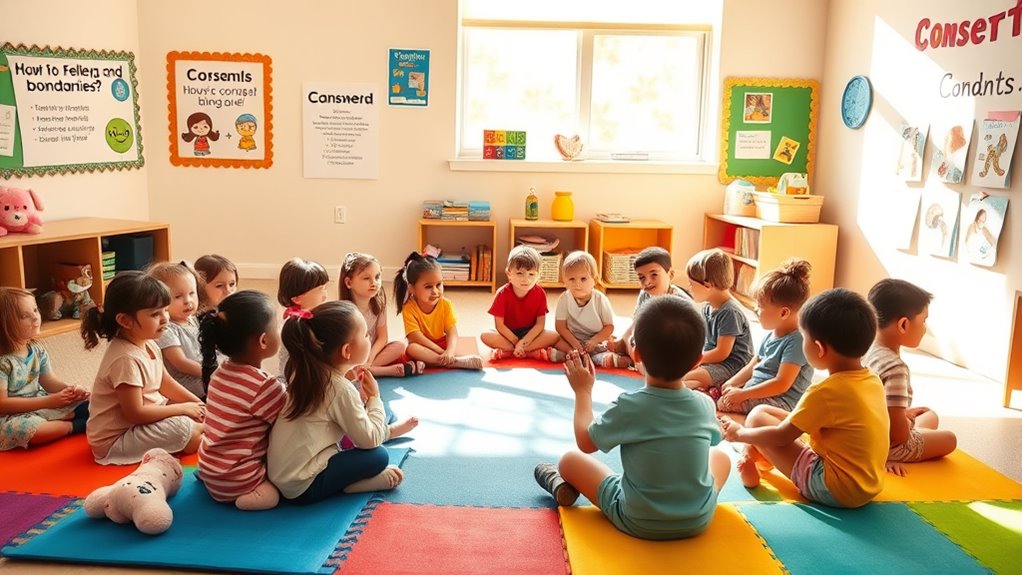To introduce consent to kindergarteners, start with simple conversations about everyday situations, like asking permission before hugging or touching. Use clear, easy language such as “Can I hug you?” or “Is this okay?” Encourage your child to ask for permission and respect others’ responses. Role-playing and stories help make these lessons engaging and understandable. If you continue exploring, you’ll discover more effective ways to foster respectful boundaries early on.
Key Takeaways
- Use simple phrases like “Can I hug you?” to teach asking permission before physical contact.
- Role-play scenarios where children practice saying “yes” or “no” to touches or activities.
- Share stories featuring characters asking permission and respecting each other’s boundaries.
- Encourage children to express their feelings about touch and respect their responses.
- Reinforce the idea that it’s okay to change their mind and communicate boundaries confidently.

Teaching consent from kindergarten might seem early, but it lays an essential foundation for healthy boundaries and respectful relationships. At this age, children are just beginning to understand their own feelings and how to recognize those of others. Introducing concepts like personal boundaries helps them grasp that their body belongs to them and that they have the right to say no to things that make them uncomfortable. When you talk about respectful touch, you’re teaching kids that physical contact should always be consensual and kind. This means guiding them to understand that they can ask permission before touching someone else and that others have the right to decline.
You can start simple conversations around these ideas by using everyday situations. For example, if your child wants to hug a friend or family member, you might say, “It’s nice to want to hug, but let’s ask if they’re okay with it first.” This introduces the idea of respectful touch and encourages them to seek consent in a gentle, age-appropriate way. Equally important is teaching them to listen to a “no” or a hesitant response without pressure. Reinforcing that it’s okay to change their mind and that their feelings are valid helps them develop confidence in setting boundaries.
Start conversations about consent with simple, respectful requests before physical contact.
Children are naturally curious and often imitate what they see. If you model respectful behavior—asking for permission before touching your child’s hand or respecting their wishes—you create a powerful example. When your child learns that personal boundaries are about respecting themselves and others, they start to internalize these lessons naturally. Use simple language like “Your body is yours,” or “You can say no if you don’t want a hug,” to make these ideas clear. Keep conversations positive and reassuring, emphasizing that respecting boundaries keeps everyone safe and happy. Additionally, understanding that color accuracy impacts overall image quality helps children associate clarity with respectful communication and understanding.
Incorporating stories or role-playing can make these lessons engaging. For example, you might read a story where characters ask permission before touching or share scenarios where characters respect each other’s personal space. Through these activities, children learn to recognize and communicate their feelings about physical contact and boundaries. Remember, the goal is to normalize respectful interactions early on so that your child feels confident to advocate for themselves and respect others as they grow.
Frequently Asked Questions
How Can I Introduce Consent Without Scaring Young Children?
When introducing consent to young children, focus on personal boundaries and respectful communication. Use simple language and relatable examples, like asking permission before hugging or sharing toys. Keep the conversation positive and age-appropriate, emphasizing they have a right to say no and be listened to. This approach helps them understand consent without feeling scared, fostering healthy habits for respecting themselves and others as they grow.
What Are Signs My Child Understands Consent?
Think of your child’s understanding of consent like a dance—you watch for their body language and listen for verbal cues. If they say “no” clearly or turn away, it shows they understand they control their body. When they respect others’ boundaries, like stopping when someone says “stop,” it’s a sign they’re learning consent. You’ll notice they confidently express their comfort or discomfort, showing they grasp the concept.
How Do I Handle if My Child Says No to a Friend?
When your child says no to a friend, you should respect their boundaries and encourage them to speak up. Help them understand that their feelings are valid and that they have the right to set limits. Use this as an opportunity to foster empathy development, guiding your child to recognize and respect others’ boundaries too. Reinforce that saying no is okay, and support them in feeling confident to do so.
Should I Use Books or Stories to Teach Consent?
Using books or stories is a great way to teach consent, especially with storytelling techniques that capture your child’s attention. Choose stories with age-appropriate language that clearly show characters respecting boundaries. You can pause to ask questions, encouraging your child to think about how they’d feel and what they should do in similar situations. This interactive approach makes learning about consent natural and engaging for young children.
When Is the Right Age to Start More Detailed Conversations?
Timing is everything, and knowing when to have detailed conversations depends on your child’s developmental readiness. You’ll want to gauge their understanding and comfort level, so don’t rush the process. Age-appropriate timing varies, but as your child matures, they become more capable of grasping complex ideas. Trust your instincts and create a safe space, gradually introducing more detailed topics when they show curiosity and readiness.
Conclusion
Starting conversations about consent in kindergarten sets a strong foundation for healthy boundaries. Did you know that children as young as three can understand the concept of personal space? By using simple, age-appropriate language, you empower them to respect their own feelings and those of others. Teaching consent early helps prevent issues later on, creating a safer, more respectful environment. Your effort now shapes confident, considerate individuals for the future.










